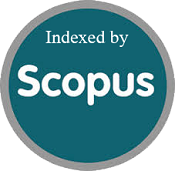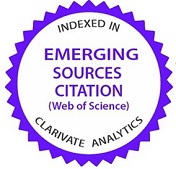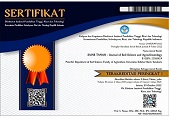Differential herbicide persistence and shifts in soil bacterial communities in Alfisol and Inceptisol
Abstract
Weeds significantly reduce crop yields and promote herbicide use, accounting for 80% of agricultural pesticides. However, herbicide persistence and toxicity adversely affect soil microbial communities, impacting soil health and productivity. This study compared the effects of organic (Vinegar-weed-care: acetic acid) and chemical herbicides (PrimextraGold: Atrazine + S-metolachlor; Imazapyr: Isopropyl amine) on soil bacteria in Alfisol and Inceptisol from Ibadan, Nigeria. Soils were analysed for physical properties and microbial DNA, and herbicide degradation was tracked using GC-MS at 0, 4, 8, and 12 weeks. Alfisol exhibited higher fertility with pH 6.2, organic carbon 3.9 g kg-1, nitrogen 0.7 g kg-1, and phosphorus 25.9 mg kg-1, compared to Inceptisol (pH 5.5, organic carbon 1.9 g kg-1, nitrogen 0.6 g kg-1, phosphorus 20.8 mg kg-1). Herbicide persistence was greater in Alfisol: metolachlor (84.94%) and Imazapyr (61.00%) vs. Inceptisol (52.55% and 50.15%, respectively). Organic herbicide metabolites also persisted more in Alfisol (35.13%) than in Inceptisol (28.00%). In non-sterile Alfisol, biodegradation of PrimextraGold and Imazapyr was lower (43.46% and 10.30%) than in sterile soils (53.97% and 16.17%), while the organic herbicide biodegraded more in non-sterile (23.49%) than in sterile (17.08%). In non-sterile Inceptisol, Imazapyr degraded less (8.94%–31.72%) than in sterile (29.49%–34.75%), but atrazine degraded more in non-sterile (61.96%–68.17%). Organic acetamide degraded better in non-sterile Inceptisol (23.42%–90.5%) than in sterile (12.47%–30.7%). Chemical herbicides reduced Candidatus Udaeobacter, Pedosphaera, and Chthoniobacter in Alfisol, while organic herbicides enhanced them in both soils. These findings highlight the ecological benefits of soil-friendly organic herbicides.
Keywords
Full Text:
PDFReferences
Abouziena, H., & Haggag, W. (2016). Weed control in clean agriculture: a review. Planta daninha, 34(2), 377-392. https://doi.org/10.1590/S0100-83582016340200019.
Axelsson, M., & Gentili, F. (2014). A Single-Step Method for Rapid Extraction of Total Lipids from Green Microalgae. PLOS ONE, 9(2), e89643. https://doi.org/10.1371/journal.pone.0089643.
Babal, B., Sharma, M., Bijani, H., & Phogat, V. (2022). Impact of soil properties on persistence of herbicides: A review. The Pharma Innovation Journal, 11(4), 463-466. https://www.thepharmajournal.com/archives/2022/vol11issue4/PartG/11-3-403-465.pdf.
Bonfleur, E. J., Kookana, R. S., Tornisielo, V. L., & Regitano, J. B. (2016). Organomineral Interactions and Herbicide Sorption in Brazilian Tropical and Subtropical Oxisols under No-Tillage. Journal of Agricultural and Food Chemistry, 64(20), 3925-3934. https://doi.org/10.1021/acs.jafc.5b04616.
Bouyoucos, G. J. (1962). Hydrometer Method Improved for Making Particle Size Analyses of Soils. Agronomy Journal, 54(5), 464-465. https://doi.org/10.2134/agronj1962.00021962005400050028x.
Breidenbach, B., Pump, J., & Dumont, M. G. (2016). Microbial Community Structure in the Rhizosphere of Rice Plants [Original Research]. Frontiers in Microbiology, Volume 6 - 2015. https://doi.org/10.3389/fmicb.2015.01537.
Bremner, J. M., & Mulvaney, C. S. (1982). Nitrogen—Total. In Methods of Soil Analysis (pp. 595-624). https://doi.org/10.2134/agronmonogr9.2.2ed.c31
Chen, W. F., Wang, E. T., Ji, Z. J., & Zhang, J. J. (2021). Recent development and new insight of diversification and symbiosis specificity of legume rhizobia: mechanism and application. Journal of Applied Microbiology, 131(2), 553-563. https://doi.org/10.1111/jam.14960.
Chowdhury, I. F., Rohan, M., Stodart, B. J., Chen, C., Wu, H., & Doran, G. S. (2021). Persistence of atrazine and trifluralin in a clay loam soil undergoing different temperature and moisture conditions. Environmental Pollution, 276, 116687. https://doi.org/10.1016/j.envpol.2021.116687.
FAO. (2022). Crops and livestock products. Food and Agriculture Organization of The United Nations. Retrieved Aug 8, 2022 from https://www.fao.org/faostat/en/#data/QCL
Gioria, M., Carta, A., Baskin, C. C., Dawson, W., Essl, F., Kreft, H., . . . Pyšek, P. (2021). Persistent soil seed banks promote naturalisation and invasiveness in flowering plants. Ecology Letters, 24(8), 1655-1667. https://doi.org/10.1111/ele.13783.
Glaspie, C. F., Jones, E. A. L., Penner, D., Pawlak, J. A., & Everman, W. J. (2021). Effect of Clay, Soil Organic Matter, and Soil pH on Initial and Residual Weed Control with Flumioxazin. Agronomy, 11(7), 1326. https://doi.org/10.3390/agronomy11071326.
Hussain, S., Muhammad, A., Dirk, S., R., S. S., D., B. G., Marion, D.-L., . . . and Martin-Laurent, F. (2015). Abiotic and Biotic Processes Governing the Fate of Phenylurea Herbicides in Soils: A Review. Critical Reviews in Environmental Science and Technology, 45(18), 1947-1998. https://doi.org/10.1080/10643389.2014.1001141.
Kaiser, K., Wemheuer, B., Korolkow, V., Wemheuer, F., Nacke, H., Schöning, I., . . . Daniel, R. (2016). Driving forces of soil bacterial community structure, diversity, and function in temperate grasslands and forests. Scientific Reports, 6(1), 33696. https://doi.org/10.1038/srep33696.
Kaur, R., Singh, D., Kumari, A., Sharma, G., Rajput, S., Arora, S., & Kaur, R. (2023). Pesticide residues degradation strategies in soil and water: a review. International Journal of Environmental Science and Technology, 20(3), 3537-3560. https://doi.org/10.1007/s13762-021-03696-2.
Kubiak, A., Wolna-Maruwka, A., Niewiadomska, A., & Pilarska, A. A. (2022). The Problem of Weed Infestation of Agricultural Plantations vs. the Assumptions of the European Biodiversity Strategy. Agronomy, 12(8), 1808. https://doi.org/10.3390/agronomy12081808.
MacLaren, C., Storkey, J., Menegat, A., Metcalfe, H., & Dehnen-Schmutz, K. (2020). An ecological future for weed science to sustain crop production and the environment. A review. Agronomy for Sustainable Development, 40(4), 24. https://doi.org/10.1007/s13593-020-00631-6.
McLean, E. O. (1965). Aluminum. In Methods of Soil Analysis (pp. 978-998). https://doi.org/10.2134/agronmonogr9.2.c16
Meng, X., Guo, Y., Wang, Y., Fan, S., Wang, K., & Han, W. (2022). A Systematic Review of Photolysis and Hydrolysis Degradation Modes, Degradation Mechanisms, and Identification Methods of Pesticides. Journal of Chemistry, 2022(1), 9552466. https://doi.org/10.1155/2022/9552466.
Michael, I., Abamba, E. E., Chikukula, A. A., Dugeri, D. R., Ibeneme, U. J., Olukayode, O. J., . . . Akpome, A. (2024). Herbicides Effects on Soil Functions: A Review. Asian Soil Research Journal, 8(4), 34-41. https://doi.org/10.9734/asrj/2024/v8i4160.
Momoh, O., Okonkwo, P. C., & Edomwonyi-Otu, L. C. (2021). Kinetic evaluation of petroleum refinery wastewater biodegradation in an activated sludge process. Nigerian Journal of Technology, 40(5), 855-860. https://doi.org/10.4314/njt.v40i5.11.
Murphy, J., & Riley, J. P. (1962). A modified single solution method for the determination of phosphate in natural waters. Analytica Chimica Acta, 27, 31-36. https://doi.org/10.1016/S0003-2670(00)88444-5.
Okalebo, J. R., Gathua, K. W., & Woomer, P. L. (2002). Laboratory methods of soil and plant analysis: a working manual second edition (2nd ed., Vol. 21). Sacred Africa, Nairobi.
Pertile, M., Sousa, R. M. S., Mendes, L. W., Antunes, J. E. L., Oliveira, L. M. d. S., de Araujo, F. F., . . . Araujo, A. S. F. (2021). Response of soil bacterial communities to the application of the herbicides imazethapyr and flumyzin. European Journal of Soil Biology, 102, 103252. https://doi.org/10.1016/j.ejsobi.2020.103252.
Pose-Juan, E., Igual, J. M., Sánchez-Martín, M. J., & Rodríguez-Cruz, M. S. (2017). Influence of Herbicide Triasulfuron on Soil Microbial Community in an Unamended Soil and a Soil Amended with Organic Residues [Original Research]. Frontiers in Microbiology, Volume 8 - 2017. https://doi.org/10.3389/fmicb.2017.00378.
Rasool, S., Rasool, T., & Gani, K. M. (2022). A review of interactions of pesticides within various interfaces of intrinsic and organic residue amended soil environment. Chemical Engineering Journal Advances, 11, 100301. https://doi.org/10.1016/j.ceja.2022.100301.
Saini, R., & Singh, S. (2019). Use of natural products for weed management in high-value crops: An Overview. American Journal of Agricultural Research, 4(25), 1-13. https://doi.org/10.28933/ajar-2018-11-2808.
Scarrow, R. (2021). Weeds represent growing threat to crop yields. Nature Plants, 8(1), 7-7. https://doi.org/10.1038/s41477-021-01060-3.
Scavo, A., & Mauromicale, G. (2020). Integrated Weed Management in Herbaceous Field Crops. Agronomy, 10(4), 466. https://doi.org/10.3390/agronomy10040466.
Schreiber, F., Scherner, A., Andres, A., Concenço, G., Ceolin, W. C., & Martins, M. B. (2018). Experimental methods to evaluate herbicides behavior in soil. Weed Control Journal, 17(1), 71-85. https://doi.org/10.7824/rbh.v17i1.540.
Sebastian, D. J., Nissen, S. J., Westra, P., Shaner, D. L., & Butters, G. (2016). Influence of soil properties and soil moisture on the efficacy of indaziflam and flumioxazin on Kochia scoparia L. Pest Management Science, 73(2), 444-451. https://doi.org/10.1002/ps.4300.
Sim, J. X. F., Drigo, B., Doolette, C. L., Vasileiadis, S., Karpouzas, D. G., & Lombi, E. (2022). Impact of twenty pesticides on soil carbon microbial functions and community composition. Chemosphere, 307, 135820. https://doi.org/10.1016/j.chemosphere.2022.135820.
Singh, B., & Singh, K. (2016). Microbial degradation of herbicides. Critical Reviews in Microbiology, 42(2), 245-261. https://doi.org/10.3109/1040841X.2014.929564.
Smith, O. M., Cohen, A. L., Reganold, J. P., Jones, M. S., Orpet, R. J., Taylor, J. M., . . . Crowder, D. W. (2020). Landscape context affects the sustainability of organic farming systems. Proceedings of the National Academy of Sciences, 117(6), 2870-2878. https://doi.org/10.1073/pnas.1906909117.
Takeshita, V., Mendes, K. F., Alonso, F. G., & Tornisielo, V. L. (2019). Effect of Organic Matter on the Behavior and Control Effectiveness of Herbicides in Soil. 37, -. https://doi.org/10.1590/s0100-83582019370100110.
Tejada, M., & Benítez, C. (2017). Flazasulfuron behavior in a soil amended with different organic wastes. Applied Soil Ecology, 117-118, 81-87. https://doi.org/10.1016/j.apsoil.2017.05.009.
Thomas, G. W. (1996). Soil pH and Soil Acidity. In Methods of Soil Analysis (pp. 475-490). https://doi.org/10.2136/sssabookser5.3.c16
Tripathi, B. M., Kim, M., Kim, Y., Byun, E., Yang, J.-W., Ahn, J., & Lee, Y. K. (2018). Variations in bacterial and archaeal communities along depth profiles of Alaskan soil cores. Scientific Reports, 8(1), 504. https://doi.org/10.1038/s41598-017-18777-x.
Walkley, A., & Black, I. A. (1934). An examination of the method for determining soil organic matter and proposed modification of the chromic acid titration method. Soil Science, 37(1), 29-38. https://doi.org/10.1097/00010694-193401000-00003
Wang, H., Ren, W., Xu, Y., Wang, X., Ma, J., Sun, Y., . . . Teng, Y. (2024). Long-term herbicide residues affect soil multifunctionality and the soil microbial community. Ecotoxicology and Environmental Safety, 283, 116783. https://doi.org/10.1016/j.ecoenv.2024.116783.
Webber III, C. L., White Jr, P. M., Shrefler, J. W., & Spaunhorst, D. J. (2018). Impact of acetic acid concentration, application volume, and adjuvants on weed control efficacy. Journal of Agricultural Science, 10(8), 1-6. https://doi.org/10.5539/jas.v10n8p1
Willms, I. M., Rudolph, A. Y., Göschel, I., Bolz, S. H., Schneider, D., Penone, C., . . . Nacke, H. (2020). Globally Abundant “<i>Candidatus</i> Udaeobacter” Benefits from Release of Antibiotics in Soil and Potentially Performs Trace Gas Scavenging. mSphere, 5(4), 10.1128/msphere.00186-00120. https://doi.org/10.1128/msphere.00186-20.
Zhang, Q., Xue, C., & Wang, C. (2015). Effects of imidacloprid on soil microbial communities in different saline soils. Environmental Science and Pollution Research, 22(24), 19667-19675. https://doi.org/10.1007/s11356-015-5154-7.
Refbacks
- There are currently no refbacks.











.png)





